A tribute to Lt. Gen. B.C. Nanda, who recaptured Siachen, the world’s highest Army Post, from Pakistan
By Santhosh Thammaiah, Columnist and Journalist
You might be aware of the latest development. The Prime Minister’s Office has called for an emergency meeting. Senior Intelligence officers will be present and you are requested to be present with your staff with a detailed report.”
When such a fax arrived at the Delhi Army HQ from Prime Minister Rajiv Gandhi’s Office in 1987, the Army Chief was startled. Well-known as the Honest General, Gen. Krishna Swamy Sundarji knew about the situation but did not have enough time to prepare as the Chief of the Northern Command was supposed to arrive from Udhampur. It was important to sit with him and prepare for the meeting at PM’s Office in New Delhi. Which meant the Army Chief and the Chief of the Northern Command wouldn’t have time to sleep.
The next day when the Chief of the Northern Command arrived for the meeting at 10 am at the PM’s Office, the Army Chief, his deputies, Intelligence Officers, Prime Minister and the Defence Minister were all seated. After a few minutes of silence, the Prime Minister began his conversation with a mention of 1949 Karachi Treaty with Pakistan and put forth the agenda for the meeting.
The Army Chief and the Chief of the Northern Command looked at each other with an appreciation on the PM’s ability to present the situation so eloquently and thoroughly. The way he presented with historical references, the Army heads knew it was time to pull out their weapons from the barracks.
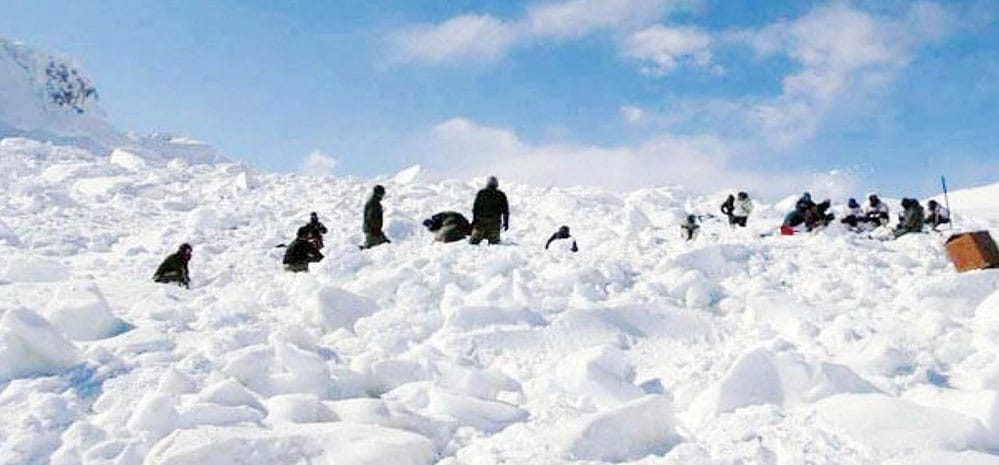
The Siachen Glacier located in the Eastern Karakoram Range of the Himalayas.
Strategic meeting
The PM had said, “We have conducted ourselves as per the 1949 Karachi Agreement and as per the agreement we have withdrawn our forces from the borders. We respected the agreement and we have even withdrawn from ‘NJ Point 9842’. But now I feel that might have been our first mistake. Because Pakistan is now planning to handover that territory to China and they are eyeing Siachen Glacier. What is disturbing is that our key post Saltoro Ridge has been occupied by Pakistan a week back. You know Chief, Pakistan has named it “Quaid Post” after Mohammad Ali Jinnah and have set up their army post.”
“Yes, Mr. Prime Minister, I understand. The strategy for the future will be explained by our Chief of the Northern Command, Lieutenant General B.C. Nanda (Biddanda),” said Army Chief Krishna Swamy Sundarji. Lt.Gen. Nanda spread a large map on the table and started presenting. “If we closely examine the new post setup by Pakistanis, it clearly indicates that they are trying to challenge us. They have violated the peace agreement and occupied our territory. Also they have named it after Jinnah. It is very difficult to recapture this post which is located at 21,153ft above the main sea level. But it is possible. We have to recapture it at any cost. Mr. Prime Minister, any country would always have an eye on a place like Siachen Glacier. They will fight even to protect even an inch of that land. The one who controls Siachen can control a key part of Asia.”
Even though the Prime Minister was in agreement, the Defence Minister seemed to feel that the nation might misconstrue and point fingers at the Congress government. He showed a sense of irritation at those suggestions, just the way Baldev Singh felt in 1947, Krishna Menon in 1962. “Lt.Gen. B.C. Nanda, you seem to be doubtful of capturing it and even if you capture do you have a plan to protect it,” questioned the then Defence Minister.
Two Army officials stood up and said, “Yes we have an answer.” They closed the historical agreement which caused such embarrassment and the meeting came to an end. The Army was all set to leave immediately to Siachen. Army General Krishna Swamy Sundarji completely trusted Lt. Gen. Nanda.
War time
With his direct involvement in the 1962 war, Nanda had the experience of the harsh climate in Siachen Glacier. He had the freedom to pick his team. But Siachen is unlike other war zones and he knew no such battle in the world had ensued in the past. Because at such an high altitude of about 21,000 ft above the main sea level, with a freezing temperature of minus 40 degree centigrade and cold winds blowing at 45 kmph, it was a much worse enemy than the Pakistan army.
The second tallest glacier in the world had a glacier and its tributaries which few knew of its existence and approximately 75-km long. But it was impossible for a sepoy to know where it was located and which direction it flows.
Hostile weather
Interestingly, the helicopters had to survive first to ensure that human beings survived in such weather conditions. It was important to ensure that the fuel didn’t freeze. Every half hour the guns had to be heated on fire from a kerosene stove or boiled with hot water to prevent it from jamming. The human body becomes weak due to low oxygen.
More than recapturing Siachen, safety of the soldiers in such harsh weather conditions was more bothersome. But it was inevitable and Army Chief General Sundarji stationed himself at Udhampur. Just a few days back he did have a long discussion with Lt. Gen M.L. Babbar.
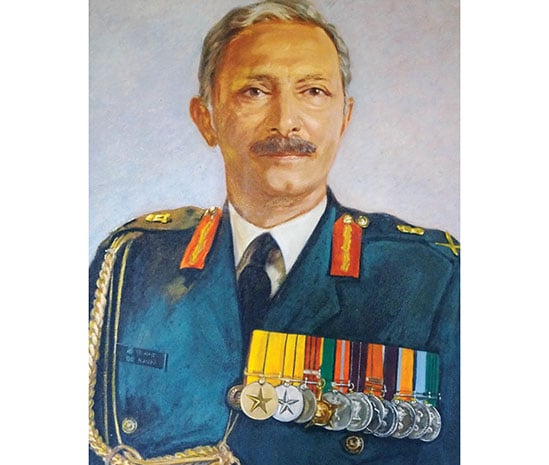
An oil painting of Lt. Gen. Biddanda C. Nanda, PVSM; AVSM.
Team Command
Finally he asked Lt. Gen. B.C. Nanda, “Where is your Best 20?” 20 Army personnel walked in hearing the bell from Lt. Gen. B.C. Nanda’s chamber. It was decided that Col. A.P. Rai would command the team consisting of Second Lt. Rajeev Pandey, Nayak Subedar Hemraj, N.S. Bana Singh and others. On June 23, the team of 20 left to Siachen in a Helicopter and their aim was Saltoro Ridge.
Death at icy mountains
At 20:30 hrs, a few soldiers of Jammu Kashmir Light Infantry left for Saltoro Ridge. It was pitch dark with freezing temperatures and the Pakistan army’s “Quaid Post” was only a few meters away. They had to take a circuitous route along the icy mountains at a height of 21,153ft. They had to walk one behind the other and had to cut through ice.
By the time one passes through a short opening, ice would fill up again. Naib Subedar Bana Singh was the tenth man and he had to undergo the agony of seeing nine of the men who were ahead of him dying. Because as they got closer “Quaid Post” they died of breathing problems. A few were killed by enemy firing.
Second Lieutenant Rajeev Pandey and N.S.Hemraj were now dead. After noticing their half-burnt body, he immediately called the command to send additional reinforcements. The next day Indian Air Force helicopter flew with 2 officers, 3 JCOs and 57 soldiers towards Sonam Post near Siachen. Thus began ‘Operation Rajiv.’ The second team took almost eight hours to cross just 150 meters. They lost two soldiers during the move.
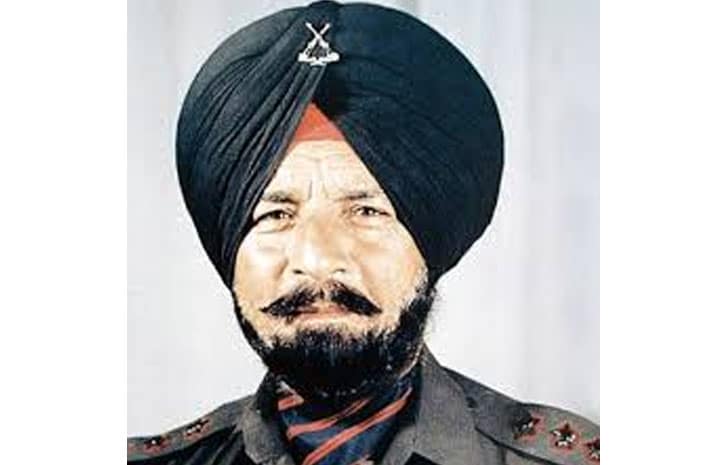
Subedar Bana Singh
First grenade hurled
On the 26th of June, the first thing Subedar Bana Singh and his team saw at sunrise was men in white uniforms — Pakistani soldiers. There was nothing the Indian Army had to wait for. Bana Singh threw the first grenade at the Pakistani bunker and it was blown into pieces. Even before the Pakistani army could realise what was happening, the Indian soldiers started firing towards them. There were a few casualties on the Indian side after heavily numbered Pakistani soldiers started firing.
Cleansing of Siachen
Col. Rai had fallen with eight bullets. Subedar Bana Singh and his companions realised that rules of the game had changed, there were no more orders. They started killing Pak soldiers indiscriminately and a few of the Pak soldiers started running away. Col. Rai asked Subedar Bana Singh to get at least a few alive. He replied that they anyway were not his cousins to save them. In a few minutes, Siachen was cleansed.
Bana Singh Post
Subedar Bana Singh applied bandage on Col. Rai’s arm. By then, four helicopters landed at Siachen. Army Chief Sundarji and Lt. Gen. B. C. Nanda arrived. By the sight of it, they realised the intensity of the fight in the steep ice walls. Army General asked Subedar Bana Singh, where was “Quaid Post” located. The damage was such. Lt. Gen. Nanda replied, “Sir, that is now Bana Singh Post” and hugged Bana Singh. Even today ‘Bana Singh Post’ exists in Siachen. Bana Singh is Siachen and Siachen is Bana Singh, the brave fight at the highest glacier in the world stays as a symbol of bravery.
Decisive battle
This is how Lt. Gen Nanda groomed fine soldiers like Subedar Bana Singh. On that eventful day, B.C. Nanda may not have been there on the battlefield but he decided the fate of that battle. Nanda, who often suggested all through his career that every valour of the brave soldiers should be awarded, sent a recommendation to the Government for one Paramveer Chakra, one Mahaveer Chakra, seven Vir Chakras and one Sena Medal.
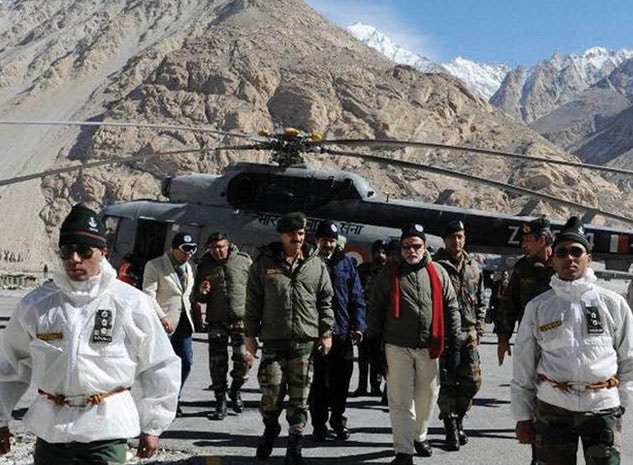
Prime Minister Modi during his surprise visit to Siachen in 2016 to celebrate Diwali with the soldiers.
Military honours
After the recapture he was entrusted with the task of modernising the base at Siachen. He increased the troop size at Siachen and ensured higher pay for troops stationed at Siachen and also brought a policy that troops can only be posted there for short-term. And today Siachen is not just world’s highest Army post, but also the well-equipped post. Siachen for Lt.Gen. Nanda was not just another Himalayan Army post, but he shaped it like a new-born baby.
For his contribution to India’s military might, Lt. Gen. Nanda was honoured with Param Vishisht Seva Medal (PVSM) and Ati Vishisht Seva Medal (AVSM).
During his tenure as the Chief of the Northern Command, he visited Siachen every month along with his wife to mingle with soldiers, share food with them and trying to distract their loneliness — because he always knew India will remain safe only if Siachen is safe. Wonder what his thoughts were when he left for his heavenly abode on Dec.12, 2018 at the age of 87. But he must have been proud that now the Prime Minister of India can freely visit Siachen.
He was called ‘Fake Environmentalist’ by greedy mafias in Kodagu
All through his life, Lt. Gen. Biddanda C. Nanda looked upto his maternal uncle Field Marshal Kodandera M. Cariappa as his role model and after his retirement he decided to settle down in Kodagu like his uncle. After his retirement and until the death of K.M. Cariappa, ‘Roshanara’, the residence of Cariappa in Madikeri had become Lt.Gen. Nanda’s centre of learning.
He learnt the importance of preserving nature and environment of Kodagu from Cariappa. By then Kodagu had begun its journey towards mindless development and destruction. Cariappa’s death was a big relief for many who were into looting the natural resources of Kodagu. Now their last obstacle was forever gone. The dance of demons towards destruction in the name of development had by then begun.
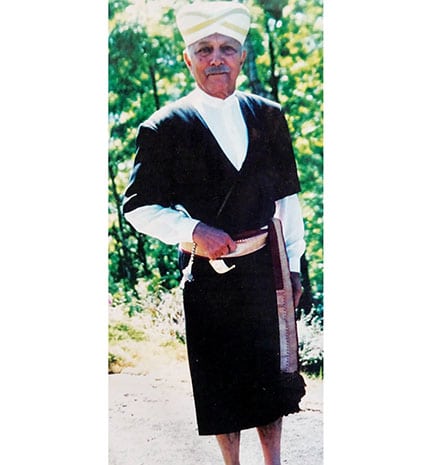
Lt. Gen. B.C. Nanda in traditional Kodava attire.
Cariappa-Thimmaiah Forum
Lt. Gen. Nanda brought together like-minded citizens and started to energise Coorg Wildlife Society. He started environment awareness programmes across the district and personally donated one acre of his land to Coorg Wildlife Society. He tried to make others realise the importance of Cariappa-Thimmaiah Forum for the overall development of Kodagu.
Hundreds of retired Army personnel from the district joined the movement under Cariappa-Thimmaiah Forum. He invited many Army officers to the district and ensured to sort the problems of the ex-servicemen from the district. B.C. Nanda had a plan to protect the environment of Coorg through discipline and dedication of the ex-servicemen of Coorg. But sadly, the district did not take notice of Nanda’s concern. He was now getting older. He stood by the protestors when thousands of trees were being axed for the high tension powerline project to Kerala through Kodagu. He demanded that the truth of environmental reports should be placed before the people.
Unfortunately everything stopped working as per his plan. Political interests and mafia started labelling him as ‘Fake Environmentalist.’ The man who planned to recapture Siachen for India couldn’t ensure his home district is protected from the powerful mafia within. With such meticulous planning he could chase the heavily armed Pakistanis at the border, but he could not stop the people who were looting his home district Kodagu. His cries “The district has reached its threshold, don’t mess with the Western Ghats,” went unheard.
About the author: Manippanda Santhosh Thammaiah hails from Nadikeri in Ponnampet, South Kodagu. At present, he is working with ‘Aseema,’ a nationalistic monthly magazine, as an Executive Editor. His weekly column ‘Haadu Hoguva Haalegalu’ is being published in ‘Hosa Diganta’ on every Wednesday.—Ed



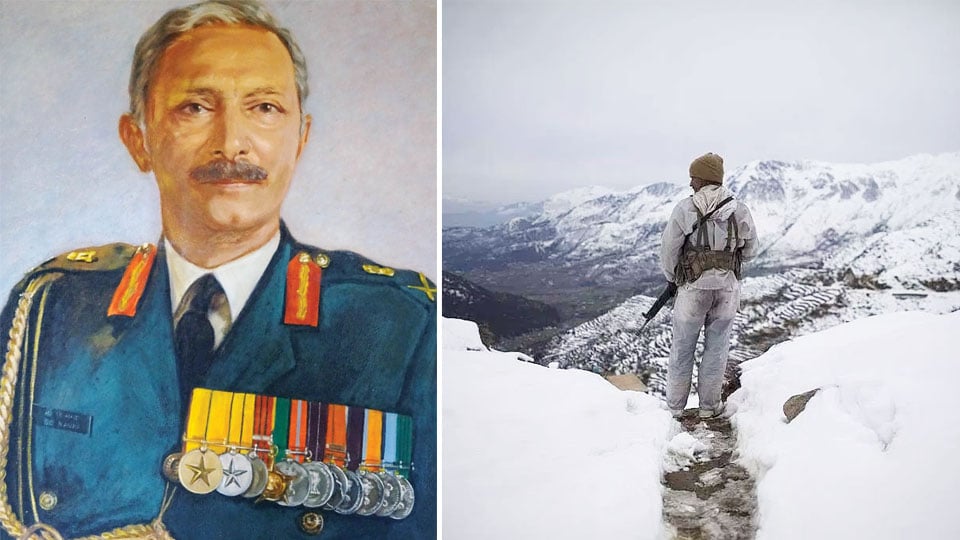
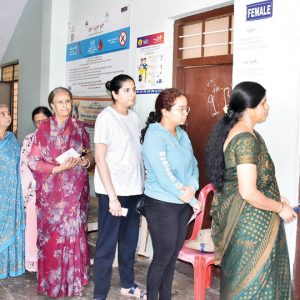
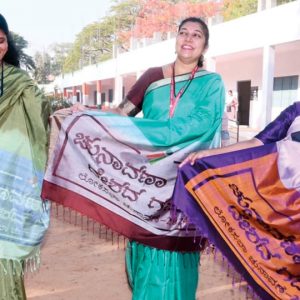
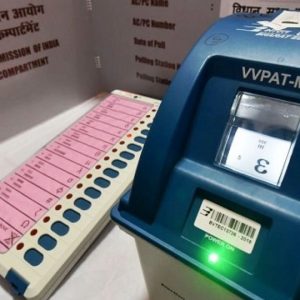

Dear Editor,
I wish to thank Santhosh Thammaiah for his touching and respectful tribute (“The Soldier who Saved Siachen”) to my late father, Lt Gen B.C. Nanda that was recently featured in your publication.
I am immensely proud of what my father achieved in his professional career and, most of all, of what he meant to me as a beloved father.
I would, however, like to correct a portion of the account here.
My father’s role model was his father, Shri B.S. Chengappa, (Chief Conservator of Forests, Andaman Islands) whose extraordinary work and contributions are held in high regard. It is from him that my father’s lifelong association with, and love of, nature and environmental issues came. It was during the early years of his childhood in the Andaman Islands that my father’s keen observations of natural life began. This was the bedrock of my father’s interest in nature and the environment.
As a young boy of 7, father was able to assist a visiting English naturalist in compiling an extensive list of local names for the fish of the Andaman waters – knowledge that he had imbibed through his passion for fishing, combined with a sharp eye and ear for all things in the natural world. Anyone who knew my father would know what an amazingly keen and astute observer of animal and bird life he was.
This passion was something he carried with him throughout his life, be it in extensive travels through his native Kodagu, or the many places he lived in, and visited, across India and overseas.
After my father retired from an illustrious career in the Indian Army in 1989, he devoted tireless hours to various causes, be it the issues and concerns of ex-servicemen, adventure sports foundations, or giving fresh direction and impetus to the Coorg Wildlife Society, to name but a few.
Over the years, my father, on his regular visits to Kodagu, visited Field Marshal Cariappa’s residence, to pay his respects as a nephew.
Also, my parents had always planned to retire in Kodagu.
Thank you once again for this tribute to my father.
With best wishes,
Shalini Nanda Nagappa
Vancouver, Canada